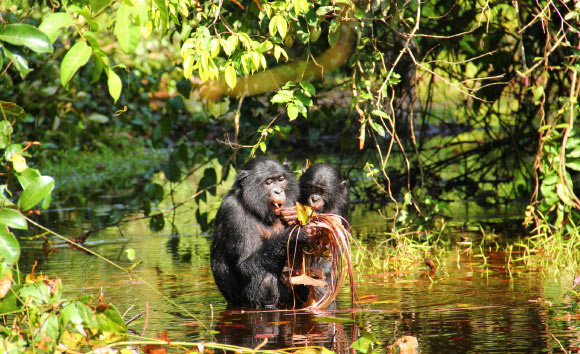A team of scientists has found that wild bonobos (Pan paniscus), our closest living primate relatives, communicate in a similar manner to human babies.

Wild bonobos feeding on lillypads. During feeding, bonobos frequently produce peep vocalizations as well as in other contexts. Image credit: Zanna Clay / Lui Kotale Bonobo Project.
The team, led by Dr Zanna Clay from the University of Birmingham, UK, found that bonobos produce a high-pitched call type, known as the ‘peep’, across a range of positive, negative and neutral situations, such as during feeding, travel, rest, aggression, alarm, nesting and grooming. These peep calls are short in duration and produced with a closed mouth.
The scientists looked at the acoustic structure and found that the calls did not vary acoustically between neutral and positive contexts.
It is this similarity in calls made across different emotional contexts that echo the similarities found in human infant vocalizations.
“When I studied the bonobos in their native setting in Congo, I was struck by how frequent their peeps were, and how many different contexts they produce them in,” said Dr Clay, who is the lead author of a paper published in the journal PeerJ.
“It became apparent that because we couldn’t always differentiate between peeps, we needed understand the context to get to the root of their communication.”
The common assumption is that calls of primates are tightly tied to certain contexts and emotional states, whereas many human vocalizations are freed from this.
However, pre-linguistic human infants can produce a group of calls, called protophones, independently of their emotional state.
These types of calls differ from commonly recognized calls such as laughter and crying, and the calls of most animals, which are thought only to be produced in certain contexts.
“We felt that it was premature to conclude that this ability is uniquely human, especially as no one had really looked for it in the great apes. It appears that the more we look the more similarity we find between animals and humans,” Dr Clay said.
The type of functional flexibility the scientists observed in bonobos could represent an important evolutionary transition from functionally fixed animal vocalizations towards flexible human vocalizations, which seems to have appeared some 6-10 million years ago in the shared common ancestor between humans and great apes.
_____
Clay Z et al. 2015. Functional flexibility in wild bonobo vocal behaviour. PeerJ 3: e1124; doi: 10.7717/peerj.1124







